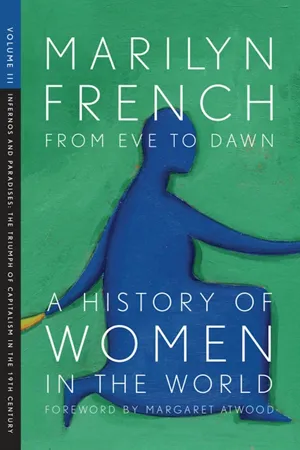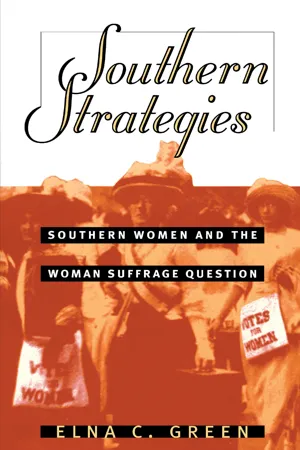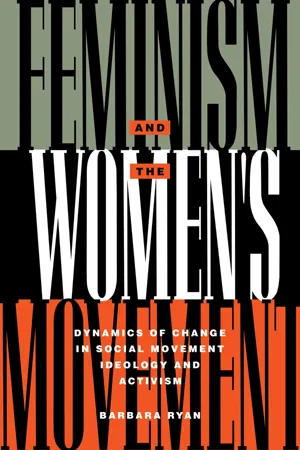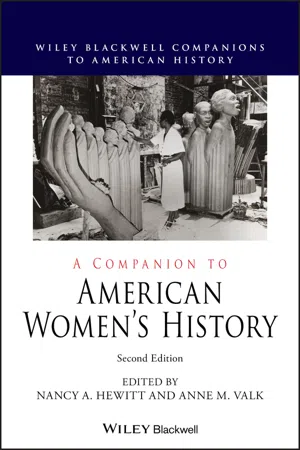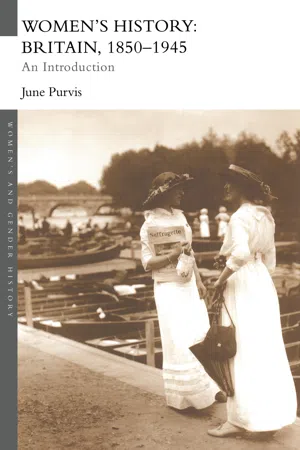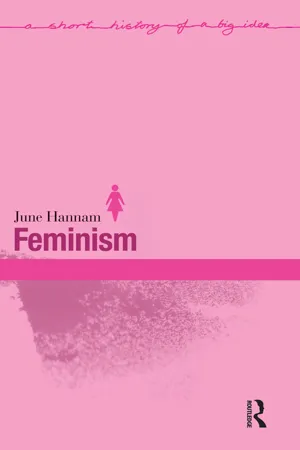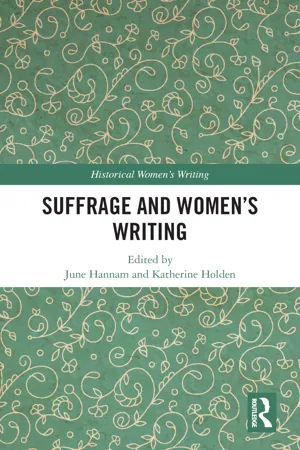History
American Suffrage Movement
The American Suffrage Movement was a social and political campaign advocating for women's right to vote in the United States. It gained momentum in the late 19th and early 20th centuries, leading to the passage of the 19th Amendment in 1920, which granted women the right to vote. The movement was a pivotal moment in the fight for gender equality and civil rights in the United States.
Written by Perlego with AI-assistance
Related key terms
10 Key excerpts on "American Suffrage Movement"
- eBook - ePub
From Eve to Dawn: A History of Women in the World Volume III
Infernos and Paradises: The Triumph of Capitalism in the 19th Century
- Marilyn French(Author)
- 2008(Publication Date)
- The Feminist Press at CUNY(Publisher)
CHAPTER 7 WOMAN SUFFRAGE IN THE UNITED STATES AND GREAT BRITAINIn the United StatesT HE AMERICAN SUFFRAGE MOVEMENT was an uneasy alliance of women whose main bond beyond their sex and inferior status was work in some area of reform. Few were militant feminists. Some were active abolitionists; most were evangelicals working in moral reform, political conservatives who claimed a right to political action on grounds of moral superiority. Their vision of women as superior collided with the feminist vision of women as like men. Conflicting interpretations of Woman’s Nature produced a tension that characterized the suffrage movement (and women’s movements into the present) in debates over education, protective legislation, maternity leave, and other issues.In the early republic, some women had the franchise: in 1783 New Jersey granted the vote to all residents of age worth £50. Only two women voted in 1787, because of confusion about eligibility, but few women had £50. Women’s participation in local elections (in large numbers in 1797), aroused male resentment: newspaper articles ridiculed “petticoat politics,” warning of a legislature “filled with petticoats.” Men opposed to women’s voting often claimed that slaves did too; an 1806 election was voided after reports that women, blacks, and white men voted more than once. After John Condict, a Republican representative from Essex County, New Jersey, was nearly defeated by women’s vote, he led a campaign to limit eligibility. In 1807 New Jersey limited the franchise to white male adults with property.In the nineteenth century, women made giant steps toward full citizenship, but won not one victory for woman suffrage. Men feared suffrage more than any other reform as a threat to “the family,” that is, to male supremacy. Too cowardly to admit this explicitly, they argued that women who wanted the vote were insulting their husbands, who always voted in the best interests of the entire family. Woman suffrage would generate domestic chaos (two voices instead of one), unsex women, and emasculate men, as women abandoned housekeeping and child-rearing, leaving them to men.1 - eBook - ePub
Southern Strategies
Southern Women and the Woman Suffrage Question
- Elna C. Green(Author)
- 2000(Publication Date)
- The University of North Carolina Press(Publisher)
1 But the ballot for women constituted a small plank in a much larger platform, as the women of Seneca Falls demanded equality for women in all areas of civil, political, economic, and private life. Much more pertinent (or so it seemed in the context of the mid-nineteenth century) were women’s rights to control their own property, their rights to guardianship of their own children, their need for equal wages and access to higher paying professional jobs, and their desire to limit the size of their families. Suffrage remained a secondary demand at best and one with which not all women activists of the nineteenth century agreed.Although suffrage remained controversial, the suffrage movement continued to gain support and respectability throughout the remainder of the century for a number of reasons. As women involved in the temperance crusade or in other reform efforts recognized their inability to influence legislators without the leverage of voting power, they learned to appreciate more the need for political clout. As women from other reform movements swelled the suffrage ranks, it ultimately became one of the largest mass movements of women in American history.2 Moreover, “votes for women” served as a focal point, a source of unity among diverse groups with different agendas. A “clear, easily understood goal” that tapped the “strain of natural rights doctrine in American thought,” suffrage united a coalition of organizations behind a common goal. What originally had seemed the least viable demand of Seneca Falls eventually became the one demand upon which nearly all the major women’s organizations agreed.3The nineteenth-century movement struggled through a series of internal troubles that threatened to undermine its effectiveness and perhaps destroy it altogether. As the Civil War ended, leading suffragists such as Elizabeth Cady Stanton and Susan B. Anthony, who had been loyal foot soldiers in the abolition movement, now asked that they be rewarded for their work on behalf of the slaves and in support of the Union war effort. They asked that the Fourteenth and Fifteenth Amendments make women, not just black males, citizens and voters. Not all their suffrage colleagues agreed with this position, however, and the disagreement splintered the movement in two.4Personality clashes and internal rivalries compounded the fundamental differences over tactics and philosophy as the suffrage movement tore itself apart. The issues at stake included how best to use chronically limited funds; whether men should be welcomed as allies; whether the Fourteenth and Fifteenth Amendments should receive suffragists’ support; and whether the focus of their subsequent efforts should be on federal or state amendments.5 A formal split, occurring in 1869, produced two competing organizations: the American Woman Suffrage Association (AWSA) and the National Woman Suffrage Association (NWSA). Although it has been argued that the split arose from personal frictions generated by a struggle for power within the leadership,6 - eBook - ePub
Feminism and the Women's Movement
Dynamics of Change in Social Movement Ideology and Activism
- Barbara Ryan(Author)
- 2013(Publication Date)
- Routledge(Publisher)
Chapter 2The Woman’s Suffrage Movement and the Aftermath of Victory[I]f woman would fulfill her traditional responsibility to her own children; if she would educate and protect from danger factory children who must find their recreation on the street; if she would bring the cultural forces to bear upon our materialistic civilization; and if she would do it all with the dignity and directness fitting one who carries on her immemorial duties, then she must bring herself to the use of the ballot—that latest implement for self-government. May we not fairly say that American women need this implement in order to preserve the home?(Jane Addams, Why Women Should Vote, 1917)Feminism is as broad and definite as we make it. . . . Political freedom—simple permission to vote—is a very tiny part of freedom, and we want all there is.(Alice Park, The Suffragist, 1920)1The split in the early woman’s movement originated over a strategic dispute, but also resulted from antagonistic feelings which had developed on the part of the leaders. When a social movement divides into contending factions, the result can be beneficial or destructive. The possible negative effects are the amount of time spent on intra-movement sectarian quarrels and internal attack. The possible benefits are increased numbers and types of participants, and the creation of new ideas, issues, and methods. The National Woman Suffrage Association and the American Woman Suffrage Association attempted to represented different segments of the population; but, because this schism was not primarily an ideological division, it was incapable of producing a significant contrast in goals or organizing efforts. Both groups were committed to the principle of equal rights for women, and both felt the vote represented that principle. As Eleanor Flexner has argued, the two groups clashed “not on whether women should vote, but on how - eBook - ePub
- Nancy A. Hewitt, Anne M. Valk, Nancy A. Hewitt, Anne M. Valk(Authors)
- 2020(Publication Date)
- Wiley-Blackwell(Publisher)
2019 ).The freshest and most enduring histories of the woman suffrage struggle use an intersectional lens to describe a movement that was multigenerational, multi‐class, multiracial, and multi‐ethnic. Nuanced, balanced, and inclusive accounts show that the effort to secure US women’s access to the vote did not start in Seneca Falls, did not end with ratification, and did not stand alone, but rather drew from and contributed to women’s movements in other nations and for other causes. These histories are vital now, as efforts to curb voting rights in recent US elections make clear. Some issues that concerned suffragists in the nineteenth and twentieth centuries are not yet settled.Origin Stories
Current scholarship honors many origins of the movement for woman suffrage. As Anne Boylan (2002 ) and others have shown, challenges to conventional thinking about gender roles in the 1820s emerged from women’s rich associational life, working‐class activism, and the pens of “freethinkers” such as Fanny Wright. These conversations expanded in the tumultuous 1830s, scarcely two generations from the American Revolution, in an era when religious upheavals challenged bedrock belief systems, an industrial boom and market revolution transformed work and confounded the boundaries between domestic and public spaces, and fierce resistance by enslaved blacks inspired urgent antislavery activism by free blacks and whites. In this same decade, the American electorate expanded dramatically as more and more white men gained access to the ballot and mass‐participation political parties mobilized them to vote. For the balance of the century, as Walter Dean Burnham (1982 ) and Jon Grinspan (2016 - eBook - ePub
Women's History: Britain, 1850-1945
An Introduction
- June Purvis, June Purvis(Authors)
- 2008(Publication Date)
- Routledge(Publisher)
Chapter Eleven Women and the vote Sandra Stanley HoltonIntroduction
Sporadic calls for the enfranchisement of women were made from the time of the 1832 Reform Bill, when women were for the first time expressly excluded from this right. But no large-scale, organized demand arose until 1865, when a new Reform Bill was anticipated, and when John Stuart Mill, the political philosopher, was elected to Parliament on a programme that included women’s suffrage.1 By this time a women’s movement was in existence, and the vote was only one of a broad range of rights sought in the following decades.2In the early years of the twentieth century the suffrage campaigns took on new colour and new urgency with the emergence of a younger generation of leaders of charismatic power, and with the adoption of “militant” methods far more sensational than those of earlier decades.3 What remained a constant, however, was the Parliamentary focus of the campaigns, for this was the arena in which the question would be decided. Equally, the political interests and reform goals of suffragists were rarely restricted to the gaining of the vote for their sex. Many were also seeking an overall reform of the political and social systems of Britain. For all these reasons, the internal divisions within the suffrage movement often reflected party-political, and sometimes even sectarian, struggles outside the movement itself, struggles which in turn were often the outcome of class and regional tensions within British society. The nature and course of the women’s suffrage movement cannot be understood, then, outside the broader settings of the women’s movement, and of Parliamentary politics.4 - Chapter 3 Women’s suffrage, 1860s–1920sWHY WAS WOMEN’S SUFFRAGE such a controversial issue and why did it take so long to achieve? Why did women want the vote so badly and why has it had such a central place in histories of feminism? To what extent did suffrage campaigns make a difference to the achievement of the vote? Both supporters and opponents believed that women would use the vote to bring about social and political change. But more than that contemporaries feared that if women had a political voice then the ‘traditional’ relationship between men and women in the family and the workplace would come under threat. Feminists certainly recognized the symbolic importance of the vote. It signified the possibility of women acting together across national boundaries to transform the world in which they lived. This helps to explain why it evoked such strong feelings on both sides.Sex was a key factor in deciding who should, or should not, be included in the franchise. The demand for women’s suffrage, therefore, highlighted women’s common interests and raised the possibility of a ‘universal sisterhood’. It was the one issue that brought women from a variety of backgrounds together in organized groups and in highly public campaigns. This in turn could foster a sense of solidarity among women as they faced intransigent opposition to their cause. Organized suffrage movements developed first in the ‘liberal democracies’ of Europe, North America and the white-settler colonies of Australia and New Zealand and in most cases reached a peak in the decade before the First World War. Given their size and ‘militancy’, the British and American movements took centre stage among contemporaries and also in later suffrage histories. But this should not lead us to neglect suffrage movements in other countries. They had their own priorities, aims and tactics which need to be recognized and should not simply be viewed through the eyes of Anglo-American campaigners.
- eBook - ePub
The Inner Story of the Suffrage Movement
Woman Suffrage and Politics, Woman Suffrage By Federal Constitutional Amendment
- Carrie Chapman Catt, Nettie Rogers Shuler, Mary Sumner Boyd, Henry Wade Rogers(Authors)
- 2018(Publication Date)
- Madison & Adams Press(Publisher)
Woman Suffrage and Politics
Table of ContentsPassage contains an image
HOW THE WOMAN SUFFRAGE MOVEMENT BEGAN
Table of ContentsWhen, during the last decade, the great suffrage parades,—armies of women with banners, orange and black, yellow and blue and purple and green and gold,—went marching through the streets of the cities and towns of America; when “suffrage canvassers,” knocking at the doors of America, were a daily sight; when the suffragist on the soap box was heard on every street corner; when huge suffrage mass meetings were packing auditoriums from end to end of the country; when lively “suffrage stunts” were rousing and stirring the public; when suffrage was in everybody's mouth and on the front page of every newspaper, few paused to ask how it all started, where it all came from. It was just there, like breakfast.To the unimaginative man on the street corner, watching one of those suffrage parades, the long lines of marching women may have seemed to come out of no-where, to have no starting place, no connection with his grandmother and his great grandmother. To the same man the insistent tapping of those suffrage canvassers, the commotion of the suffrage mass meetings, the repetition of those suffrage stunts, the incessant news of suffrage in the daily press, may have seemed unrelated acts, irrelevant to social history. Yet it was all part of social history, and had immediate connection with other phases of social history. For the demand for woman suffrage was the logical outcome of two preceding social movements, both extending over some centuries: one, a man movement, evolving toward control of governments by the people, the other a woman movement, with its goal the freeing of women from the masculine tutelage to which law, religion, tradition and custom bound them. These movements advanced in parallel lines and the enfranchisement of woman was an inevitable climax of both.Neither the man movement nor the woman movement had a dated beginning. In the struggle upward toward political freedom, men were called upon to overthrow the universally accepted theory of the Divine Right of Kings to rule over the masses of men; women, the universally accepted theory of the Divine Right of Men to rule over women. The American Revolution forever destroyed the Divine Right of Kings theory in this country, but it left untouched the theory of the Divine Right of Man to rule over woman. Men and women believed it with equal sincerity, the church taught it, customs were based upon it, the law endorsed it, and the causes which created the belief had been so long lost in obscurity that men claimed authority for it in the “laws of God.” All opposition to the enfranchisement of women emanated from that theory. - eBook - ePub
Silencing the Opposition
How the U.S. Government Suppressed Freedom of Expression During Major Crises, Second Edition
- Craig R. Smith, Craig R. Smith(Authors)
- 2011(Publication Date)
- SUNY Press(Publisher)
27 It was shortly after this conference in 1860 that the government answered the call for woman suffrage with legislative suppression.Advocates for women's rights willingly set aside their agenda during the Civil War to support the Union cause. While most advocates for women's rights were fierce supporters of abolition, they also believed that their loyalty to country would be rewarded once the war came to an end and that women would be extended the vote alongside African Americans. The Reconstruction amendments, however, did not enfranchise women (see chapter 3 of this book).28 In fact, a series of legislative suppressive acts would mark Reconstruction as a dramatically low point for women's rights. The first debate on woman suffrage in the Senate took place during Reconstruction, in 1866, after an amendment was proposed to strike the word “male” from a bill extending the vote to African Americans in the District of Columbia.29 The arguments against woman suffrage emerged from the topoi of cultural and religious suppression that had silenced women since the founding. Listen to the arguments from the floor of Congress in favor of the government's continued suppression of women's vote. Senator George Williams of Oregon argued that, “The woman who undertakes to put her sex in an adversary position to man, who undertakes by the use of some independent political power to contend and fight against man, displays a spirit which would, if able, convert all the now harmonious elements of society into a state of war, and make every home a hell on earth.”30 Similarly, the cult of domesticity rang from Senator Frelinghuysen's exclamation, “It seems to me as if the God of our race has stamped upon [the women of America] a milder, gentler nature, which not only makes them shrink from, but disqualifies them for the turmoil and battle of public life. They have a higher and a holier mission … Their mission is at home, by their blandishments and their love to assuage the passions of men as they come in from the battle of life, and not themselves by joining in the contest to add fuel to the very flames…. It will be a sorry day for this country when those vestal fires of love and piety are put out.”31 - eBook - ePub
- June Hannam, Katherine Holden(Authors)
- 2020(Publication Date)
- Routledge(Publisher)
It was established in 1890 through the merger of two rival suffrage societies: the National Woman Suffrage Association and the American Woman Suffrage Association. 4 Under the leadership of Susan B. Anthony, the aim of the NAWSA was to welcome all women—despite their differences—to work for the cause to enfranchise women. While the NAWSA continued to lobby for both statewide enfranchisement and a national amendment to the US constitution, 5 Harriot Stanton Blatch, Alice Paul and Lucy Burns introduced the militancy of the British suffragettes to the American Suffrage Movement. 6 They founded the Congressional Committee, an auxiliary to the NAWSA, as a platform to engage in mild militancy in support of a national amendment. They organized a suffrage parade in March 1913, the day before the inauguration of Woodrow Wilson as president. The event became even more sensational when a large crowd of onlookers assaulted the marchers, and the police did little to intervene. 7 Nevertheless, the event succeeded in reintroducing the suffrage amendment to the House of Representatives, focusing national attention on the cause. Women’s literary activity, fuelled by the progressive spirit of the era, served as a form of cultural lobbying through which they could articulate social and political problems, and propose solutions. Despite all the ideological and methodological differences, countless women writers contributed to the suffrage movement by writing fiction that targeted white, Protestant, middle-class audiences. A prominent suffragist and the co-founder of Virginia’s Equal Suffrage League (with Ellen Glasgow), Mary Johnston (1870–1936), took an active part in parades and addressed state legislatures to promote the cause - eBook - ePub
- Immanuel Ness(Author)
- 2015(Publication Date)
- Routledge(Publisher)
After Catt took the helm of NAWSA, she molded the organization into a tightly controlled lobbying machine. She considered the liquor industry the invisible enemy and charged that its corrupt practices in American politics delayed the woman suffrage victory. However, other changes at the turn of the century, outside the suffrage movement, were aiding the cause.During the Progressive Era of the late nineteenth and early twentieth centuries, the quest for woman suffrage started to become more of a mainstream issue. More activists joined the movement as women's roles in society expanded, and they saw the need for reforms strengthened by legislation. Around the country, men and women who supported Progressive reforms, such as workers' protection, and an end to child labor, political corruption, and unsafe food and drugs, recognized that women's votes could help secure these efforts.Middle-class reformers such as Jane Addams, founder of Hull-House in Chicago, Florence Kelley, executive secretary of the National Consumers League, Rose Schneiderman, labor organizer with the Women's Trade Union League, and Agnes Nestor, president of the International Glove Workers Union, worked diligently for suffrage as a way to achieve improved conditions for workers.Harriot Stanton Blatch, Stanton's daughter, returned to New York in 1902 after many years of living in England where she observed the radical and innovative British suffrage movement. She was determined to bring more working-class women into the suffrage movement to improve their economic status. She organized the Equality League of Self-Supporting Women in 1907, which became the Women's Political Union. Blatch excelled at pulling together political alliances between middle-class reformers and working class women to rally for suffrage, infusing the campaign with new life and broadening its constituency.After Catt stepped aside from the NAWSA leadership after four years to care for her dying husband, Dr. Anna Howard Shaw took over. A veteran suffragist, medical doctor, and Methodist minister, Shaw embodied the essence of an emancipated woman. While her compelling oratory championed suffrage in every state in the Union, Shaw lacked Catt's vision and organizational skills, and she struggled to steer NAWSA for eleven years until Catt returned in 1914 after her husband's death. In that capacity, Catt, who was a brilliant and effective organizer, speaker, and fundraiser for the cause, spearheaded the final ratification effort in Tennessee in 1920.
Index pages curate the most relevant extracts from our library of academic textbooks. They’ve been created using an in-house natural language model (NLM), each adding context and meaning to key research topics.
